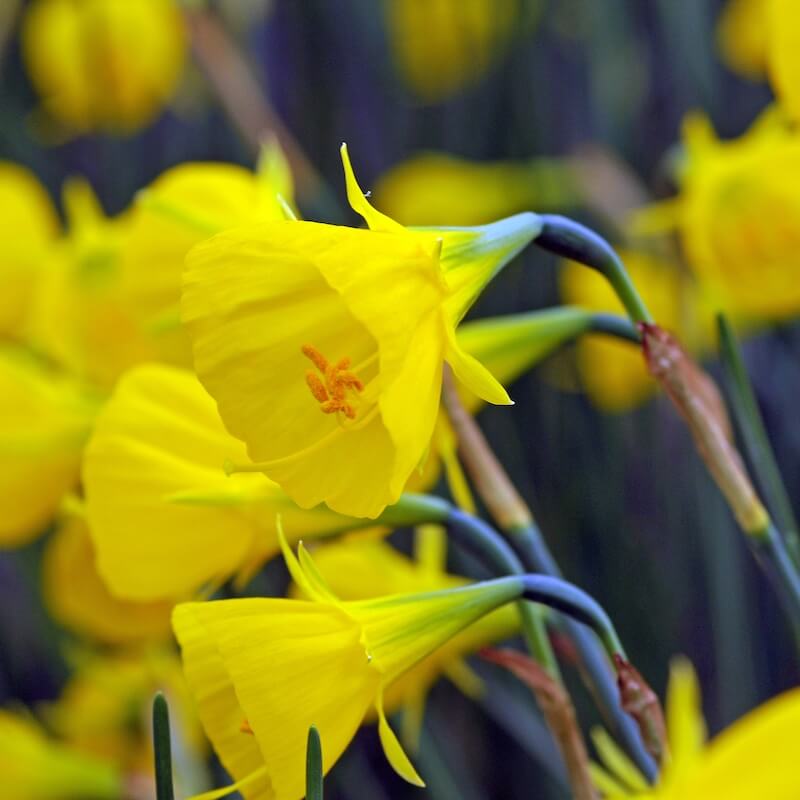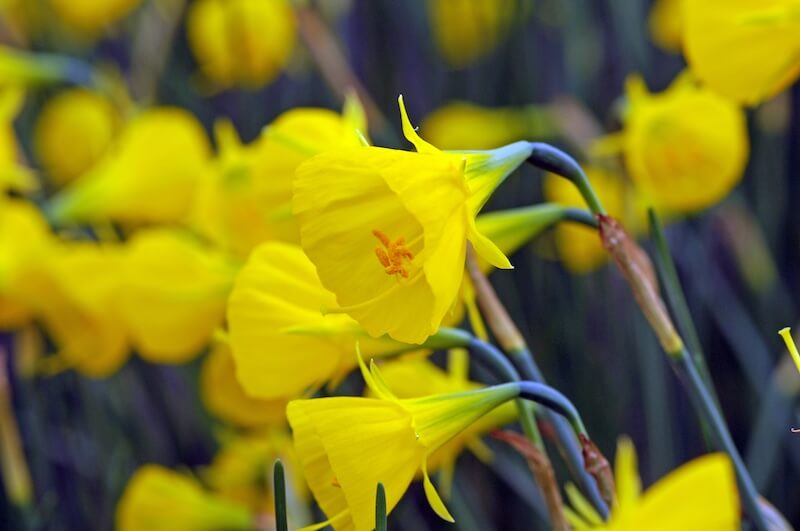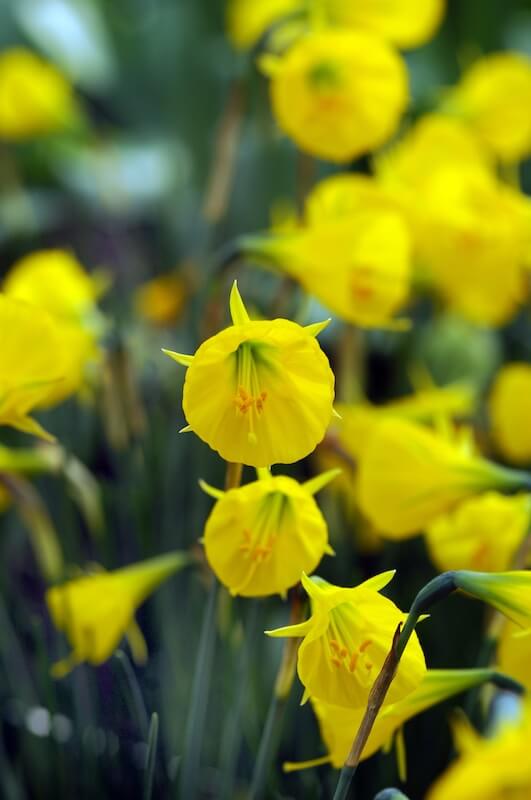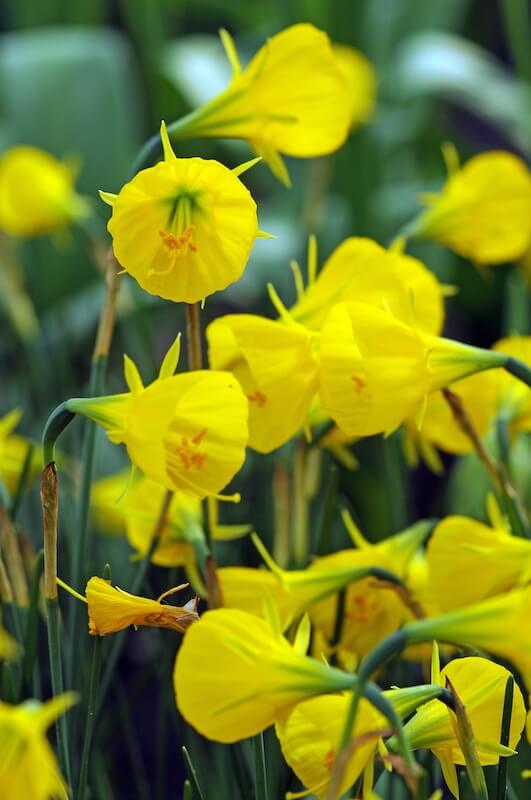
Position
- Full sun to light shade; full sun promotes the most vigorous flowering and deepest colour
- Prefers a sheltered spot, protected from strong winds
- Ideal in mixed borders, as a specimen or in large containers
Hardiness
- Tolerates winter lows down to around –20 °C (–4 °F)
- A light autumn mulch over the bulb bed aids establishment in very exposed gardens
Soil
- Thrives in fertile, well-drained soils such as loam or sandy loam
- Benefits from soil improvement at planting with garden compost or well-rotted manure
- Avoids heavy, waterlogged clay, which can cause bulb rot
- Adaptable to acid, neutral or alkaline soils
- Performs best where organic matter maintains good structure and moisture without waterlogging
- Grab a soil test kit and ensure the perfect conditions for growth
Height
- Clumps reach approximately 35–45 cm (14–18 in) in height each spring
Seasons of Interest
Additional Notes
- Plant bulbs in autumn, 12 cm deep and 10 cm apart, in groups for best impact
- Leave foliage until entirely yellow before cutting back to allow bulbs to replenish energy
- Divide and replant congested clumps every 3–4 years once leaves have died down
- Dead-head spent flowers to keep the display tidy and direct energy back into the bulb
- All parts are mildly toxic; handle bulbs with gloves and keep away from pets and children
- Suitable for naturalising in grass—lift and replace turf after flowering to avoid damage
Plant Narcissus Oxford Gold for a Golden Spring Display
Few spring bulbs bring such cheerful brightness to the garden as Narcissus bulbocodium Oxford Gold. This delightful daffodil variety is known for its unique trumpet-shaped blooms, radiant yellow colour, and early flowering season. Whether planted in beds, rockeries, or pots, it adds a royal touch of sunshine to any space, lifting spirits after the grey days of winter. Its long-lasting display, easy care, and reliable performance make it one of the best spring bulbs for UK gardens.
What Makes Narcissus Oxford Gold So Special?
Narcissus Oxford Gold stands out among daffodils for its distinctive shape and bold hue. Often called the hoop petticoat daffodil, this charming bulbocodium species features flared trumpets that resemble a golden skirt. The bright golden-yellow blooms bring warmth and vibrancy, especially when planted en masse.
This dwarf daffodil remains compact yet strong, growing to around 15cm tall with slender stems and delicate green leaves. Despite its size, its blooms are surprisingly large and eye-catching. The combination of unique form, reliable flowering, and vibrant colour makes Narcissus bulbocodium Oxford Gold a top choice for gardeners seeking something a little different.
Awarded the RHS Award of Garden Merit, this bulb is celebrated for its garden performance, resilience, and consistent bloom. It thrives in the UK climate, returning year after year with minimal care.

When Is the Best Time to Plant Narcissus Bulbs?
For the best results, plant your Narcissus Oxford Gold bulbs in autumn. This timing allows them to establish roots before the cold weather sets in. The bulbs are delivered from reputable nurseries during this period, ensuring they’re fresh and ready for planting.
Aim to plant bulbs three to four times their own depth, spacing them around 8–10cm apart. This gives each bulb room to grow without crowding. Choose a sunny or lightly shaded place with well-drained soil. Good drainage is key, as sitting in waterlogged soil can cause bulbs to rot.
Once planted, nature takes care of the rest. By early spring, strong stems will rise, each crowned with a bright bloom that signals the new season’s arrival.
How to Grow Narcissus Oxford Gold in the UK
Growing Narcissus bulbocodium Oxford Gold is simple and rewarding. These bulbs flourish across the UK, from cool northern gardens to milder southern regions. They prefer a position that gets plenty of sun, though they’ll tolerate partial shade.
For the best results, plant in a well-drained soil enriched with compost or leaf mould. Avoid heavy clay soils unless they’re improved with grit or organic matter to help drainage. Once planted, there’s little maintenance needed beyond occasional watering during dry spells.
After flowering, allow the leaves to die back naturally. This helps the bulbs store energy for the next season. The foliage may look untidy for a few weeks, but it’s essential for continued blooming.

What Does the Narcissus Oxford Gold Flower Look Like?
The flower of Narcissus Oxford Gold is a showstopper. Each bloom features a large, flared trumpet with a delicate, frilled edge — the hallmark of the bulbocodium group. The petals are almost fused into the trumpet, giving the flower a unique form unlike traditional daffodils.
The colour is a bright golden-yellow, rich and glowing under spring sunlight. The flowers appear early, often in late February or March, when few other plants are in bloom. Their vibrant colour and unusual shape make them perfect for adding cheer to pots, rockeries, or borders.
Each stem carries a single flower, but the display is long-lasting and reliable. These blooms also have a light fragrance, adding an extra sensory delight to your garden.
Can Narcissus Oxford Gold Be Grown in Pots or Containers?
Absolutely. Narcissus bulbocodium Oxford Gold performs beautifully in pots and containers. This makes it ideal for gardeners with limited space or those wanting to brighten patios, balconies, or terraces.
Use a container with good drainage holes and fill it with a free-draining compost. Mix in a bit of grit or sand to mimic the bulb’s natural growing conditions. Plant the bulbs three times their depth, ensuring the tips are just below the surface.
Place the pot in a sunny or lightly shaded spot. During the growing season, water moderately and feed with a balanced fertiliser after flowering. Once the leaves yellow, allow them to die back naturally before storing or leaving the bulbs in place for the following year.
Where to Plant Oxford Gold Daffodils in the Garden
Oxford Gold is a versatile daffodil that suits a range of garden styles. Its compact habit and unique form make it a perfect choice for rockeries, alpine beds, or the front of borders.
In larger gardens, it looks stunning when planted in drifts through grass or naturalised under trees. The bright flowers shine in early spring sunlight, contrasting beautifully with emerging green foliage.
For smaller gardens, plant them in pots or window boxes for a bright splash of colour near the house. Wherever you plant them, Narcissus bulbocodium Oxford Gold never fails to deliver a reliable and long-lasting display.
What Makes Oxford Gold So Reliable?
Reliability is one of the key strengths of Oxford Gold. Once established, these bulbs return year after year, often multiplying to form larger clumps. They’re remarkably strong for their size and can cope with the unpredictable weather we usually see across the UK.
Each bulb produces a sturdy stem topped with a trumpet-shaped bloom that resists wind and rain. The delicate, slender foliage provides a neat background without crowding other plants. With minimal care, they’ll thrive for years, offering bright, early spring colour every season.
This dependability, along with their charming appearance, has earned them the RHS Award of Garden Merit — proof of their quality and garden worthiness.
How to Care for Narcissus Oxford Gold After Flowering
Once the flowering season ends, proper aftercare ensures healthy bulbs and strong future blooms. Begin by deadheading faded flowers to prevent seed formation, which can drain the bulb’s energy.
Allow the leaves to remain until they turn yellow. These green leaves absorb sunlight and feed the bulb for next year’s growth. Resist the temptation to cut them back too early — patience pays off with stronger blooms next season.
If your bulbs are in pots, reduce watering once the foliage fades. You can move the pots to a cool, dry place for summer dormancy. For bulbs in the ground, leave them undisturbed unless overcrowding becomes an issue, in which case lift and divide them every few years.
How Long Does the Oxford Gold Daffodil Bloom For?
The blooming period for Oxford Gold typically lasts from late winter through early spring, depending on the weather. Flowers can last several weeks, especially in cooler conditions. Their long-lasting nature makes them excellent for continuous spring interest.
The blooms appear before many other spring flowers, often overlapping with snowdrops or crocuses. This early show brings much-needed brightness to the garden and signals that the growing season is well underway.
As the season progresses, the bright yellow flowers gradually give way to lush green foliage, providing a soft transition to later-blooming plants.
Why Choose Narcissus Oxford Gold for Your Garden?
There are countless reasons to include Narcissus bulbocodium Oxford Gold in your garden. Its unique form and bright golden-yellow flowers offer something different from the classic daffodil look. It’s compact yet striking, reliable yet distinctive — a small bulb with a big personality.
It’s also versatile, growing well in borders, containers, and rockeries. The variety’s strong performance across the UK makes it suitable for gardeners of all experience levels. With minimal effort, you’ll enjoy a royal display of colour each spring.
Whether you’re an experienced gardener or just starting, Oxford Gold is a joy to grow. It brings warmth, light, and charm to the garden, lifting spirits and signalling the arrival of spring.
What to Expect When Your Bulbs Are Delivered
When your Narcissus bulbocodium Oxford Gold bulbs are delivered, inspect them carefully before planting. Choose bulbs that feel firm, plump, and free from mould or soft spots. Reputable nurseries ensure only high-quality bulbs reach your garden.
Plant them promptly upon arrival in autumn, while the soil is still workable. This gives them time to establish strong roots before winter sets in. If the weather is too wet, store the bulbs in a cool, dry place until planting conditions improve.
Once in the ground, your bulbs will quietly prepare for their moment of glory. Come early spring, you’ll be rewarded with a royal display of bright, trumpet-shaped blooms that brighten even the dullest day.
From Darren’s Patch
There’s something truly uplifting about seeing Narcissus Oxford Gold light up the garden after a long, grey winter. I like to tuck these cheerful bulbs into the front of borders and rockeries where their golden trumpets can really catch the early sun. They’re small but full of character, and their reliability makes them one of my go-to bulbs each autumn. I’ve found they do just as well in pots near the house, where I can enjoy their bright faces up close on chilly March mornings. If you want a touch of spring magic with minimal effort, Oxford Gold never disappoints — it’s one of those bulbs that quietly earns its place in the garden year after year.
![]()
Key Points to Remember
- Plant Narcissus bulbocodium Oxford Gold bulbs in autumn for best results
- Choose a sunny or lightly shaded place with well-drained soil
- Plant bulbs three to four times their depth and space them 8–10cm apart
- Allow leaves to die back naturally after flowering
- Ideal for borders, rockeries, pots, and containers
- Produces bright golden-yellow, trumpet-shaped flowers in early spring
- Compact and reliable — perfect for UK gardens
- Awarded the RHS Award of Garden Merit for outstanding performance
- Bulbs are delivered in top condition from trusted nurseries
- Enjoy a long-lasting, royal display year after year
If you’re searching for a cheerful, easy-to-grow spring flower, Narcissus Oxford Gold is one of the best. With its bright, trumpet-shaped blooms, reliable performance, and graceful foliage, this dwarf daffodil adds warmth and charm wherever it’s planted. It thrives in well-drained soil, looks stunning in pots or rockeries, and brings early colour to the garden. Easy to grow and long-lasting, it’s a firm favourite for gardeners who love effortless seasonal displays. Plant these high-quality bulbs this autumn for a radiant display that will lift your garden — and your spirits — every spring.
Would you like to learn about other bulb varieties? Read about Narcissus Pink Charm here.
For more information on Spring Flowering Bulbs for your garden, please click here.

Frequently Asked Questions
Q: What is Narcissus Oxford Gold?
A: Narcissus Oxford Gold is a delightful bulbocodium daffodil known for its bright golden-yellow, trumpet-shaped flowers that bloom early in spring. Often called the hoop petticoat daffodil, it’s admired for its unique form and vibrant colour. The flowers have a large, flared cup and delicate, slender petals, creating a cheerful display in rockeries, borders, or pots. With delicate, green foliage and a reliable nature, this dwarf daffodil adds a burst of colour to the garden when few other plants are in bloom. It’s an RHS Award of Garden Merit winner, valued for its beauty and performance.
Q: How do I plant Narcissus Oxford Gold bulbs?
A: Plant Oxford Gold bulbs in autumn, ideally between September and November, when the soil is still warm. Choose a sunny or lightly shaded place with well-drained soil. Plant bulbs about 7–10cm deep and roughly twice their width apart to ensure healthy growth. Press each bulb gently into the soil, pointed end up, and water well after planting. If planting in a pot, use a gritty, free-draining compost mix. The bulbs thrive best when the soil remains moist through winter but not waterlogged, helping them establish strong roots before spring flowering.
Q: What type of soil is best for Narcissus Oxford Gold?
A: Narcissus Oxford Gold performs best in fertile, well-drained soil. It prefers sandy or loamy conditions and does not tolerate heavy, waterlogged ground. To improve drainage, mix grit or organic matter into the planting area before you plant the bulbs. This variety also grows well in rockeries or raised beds, where drainage is naturally better. Keep the soil moist during the growing season, then allow it to dry slightly once the foliage begins to die back. This helps protect the bulb and ensures reliable blooms year after year in your UK garden.
Q: When does Narcissus Oxford Gold flower?
A: Narcissus Oxford Gold typically blooms in early spring, bringing a splash of colour when gardens are still waking up from winter. The vibrant golden-yellow flowers appear on strong, slender stems and last for several weeks in cool weather. Their bright, flared trumpets add warmth and cheer to borders, containers, and rockeries. Because they bloom early, they pair beautifully with snowdrops and crocuses. The long-lasting flowers and delicate foliage help extend your garden’s seasonal display, making Oxford Gold one of the best early daffodils to plant for reliable spring colour.
Q: How do I care for Narcissus Oxford Gold after flowering?
A: Once the flowers fade, remove the spent blooms to stop the plant from producing seeds. This allows energy to return to the bulb for next year’s growth. Leave the green leaves in place until they wither naturally — they continue to feed the bulb. If grown in pots, feed the plants with a balanced bulb feed after flowering, and water lightly until the foliage dies back. Avoid cutting or tying the leaves too soon, as this can weaken future blooms. Lift and divide clumps every three or four years to maintain strong, healthy displays.
Q: Can Narcissus Oxford Gold be grown in pots or containers?
A: Yes, Oxford Gold grows beautifully in pots, troughs, and containers. Use a free-draining compost with added grit to keep the bulbs healthy. Plant bulbs closely together for a full display, but ensure each has space for root growth. Place containers in a sunny position through winter and early spring, watering sparingly to keep the compost just moist. Once flowering is finished, let the leaves die back naturally. You can either keep the bulbs in the pot for the following season or lift and store them in a cool, dry place until autumn planting time.
Q: Is Narcissus Oxford Gold scented?
A: Narcissus Oxford Gold has a gentle, sweet scent that adds an extra dimension to its cheerful spring display. While the fragrance is light rather than overpowering, it’s enough to notice when planted near pathways, patios, or doors. The soft scent complements its vibrant colour, making it a charming choice for smaller gardens, courtyards, or containers. Its delicate fragrance, combined with the trumpet-shaped flowers and bright colour, ensures this variety brings both beauty and sensory appeal to early-season planting schemes across the UK.
Q: How tall does Narcissus Oxford Gold grow?
A: Narcissus Oxford Gold is a dwarf daffodil, growing to around 15–20cm tall. Despite its compact height, it produces large, flared flowers that make a striking display. The short stems make it ideal for the front of borders, rockeries, or containers, where taller plants won’t overshadow its vibrant colour. Its neat form and delicate green leaves give a tidy appearance even after flowering. The plant’s strong stems hold the blooms upright, ensuring they remain attractive during breezy spring weather, making it a practical and colourful addition to any UK garden.
Q: Where can I buy Narcissus Oxford Gold bulbs in the UK?
A: Narcissus Oxford Gold bulbs are widely available from reputable UK nurseries, garden centres, and online bulb suppliers. They are usually sold in packs during autumn when bulbs are delivered for planting. Look for firm, healthy bulbs from trusted sources, as quality affects flowering performance. Online suppliers often provide detailed planting advice and RHS-endorsed varieties, making it easy to choose with confidence. Whether you shop locally or order online, these bright and reliable bulbs are an excellent choice for adding golden colour to your spring garden.
